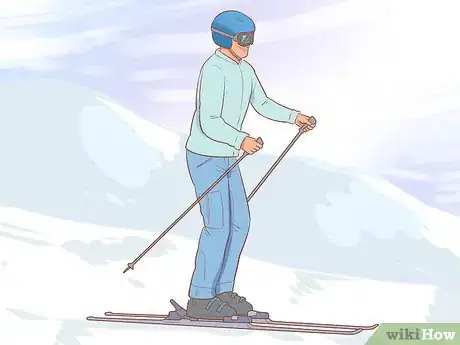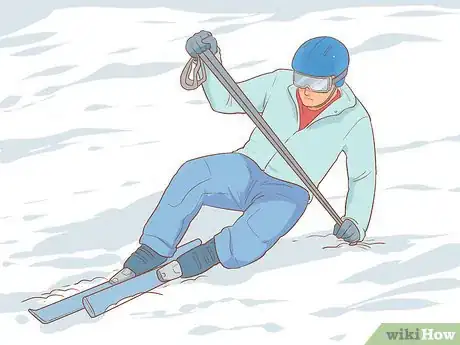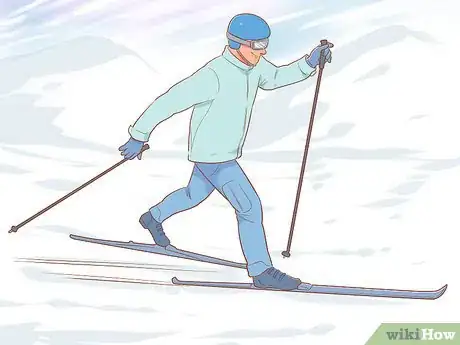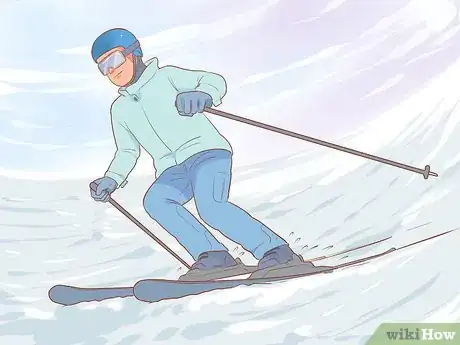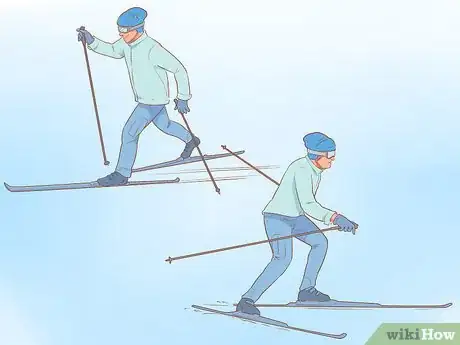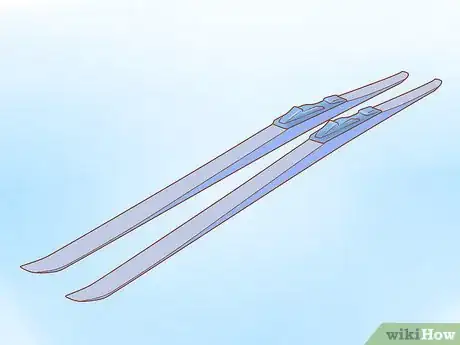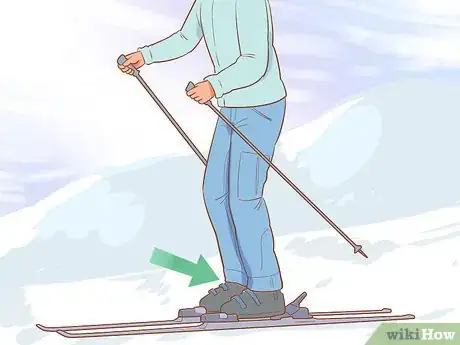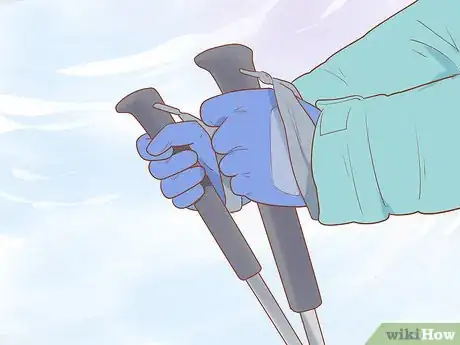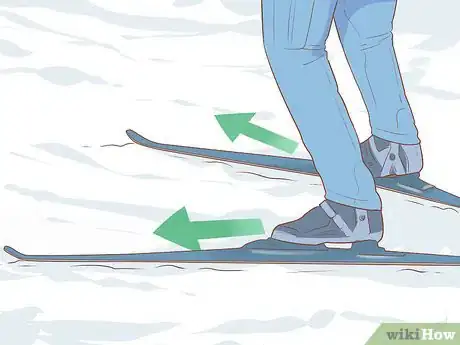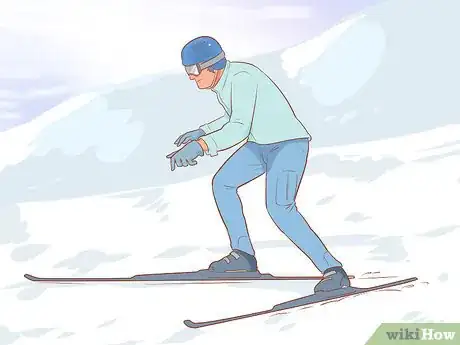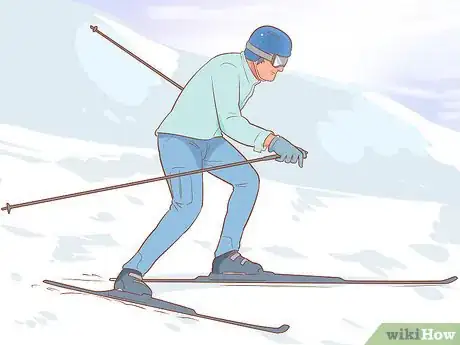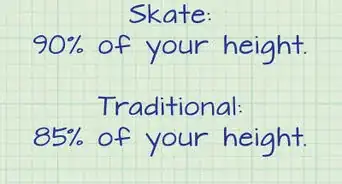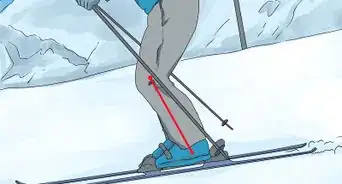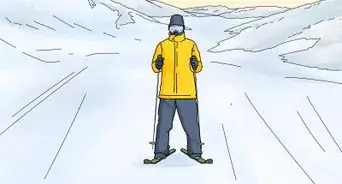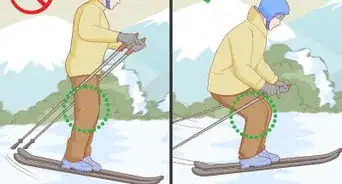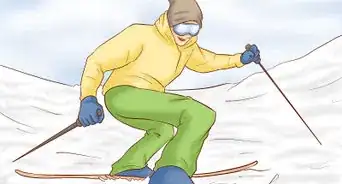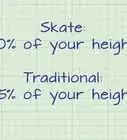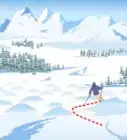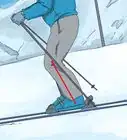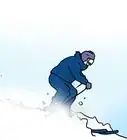This article was co-authored by Kent Bry. Kent Bry is a certified ski and snowboarding instructor and the director of Adventure Ski & Snowboard, a school based in the San Diego, California metro area. With over 50 years of skiing and snowboarding performance and instruction experience, Kent is certified by the Professional Ski Instructors of America (PSIA). Adventure Ski & Snowboard is a member of the PSIA and the American Association of Snowboard Instructors (AASI). Kent holds a BS in Recreational Therapy from San Diego State University and is also a California-registered recreational therapist.
There are 12 references cited in this article, which can be found at the bottom of the page.
wikiHow marks an article as reader-approved once it receives enough positive feedback. In this case, 100% of readers who voted found the article helpful, earning it our reader-approved status.
This article has been viewed 122,903 times.
Cross-country skiing is a popular winter sport and recreational activity. Distinguished from downhill skiing both by its technique and by its equipment, cross-country skiing involves traversing large expanses of flat snow or gentle slopes. It can be used as a workout for the upper and lower body, a means of transportation, or a way to enjoy the winter scenery. Most people begin with the traditional, classic method of cross country skiing, but you might find skate skiing easier if you already have experience with ice skating or roller skating.
Steps
Classic Cross Country Skiing
-
1Practice on a prepared trail. Any designated cross country skiing area should have smooth, groomed trails, often with two tracks to slot your skis into. This is the best way to learn cross country skiing. Skiing off the trails, or "back country" skiing, requires significantly more effort, and is only recommended once you are comfortable on the trails, and have a heavy-duty pair of skis.[1]
- If you are not at a prepared skiing area, pick a flat area of powdery snow with no obstacles.
-
2Get in the right stance. Stand on flat ground with your skis parallel to each other. Bend forward at the ankles, and slightly at your knees. Keep your torso straight, not bending at the hips.[2] This position helps keep you balanced, with your weight over your feet.[3]Advertisement
-
3Shuffle your skis forward until you can move comfortably. Scoot one ski at a time slightly forward, getting a feel for the amount of force you can apply without losing your balance or bending above the hips.
- It takes significant leg strength to turn this shuffling motion into the "kick and glide" motion described below. Many recreational skiers prefer to only use this shuffling technique of moving forward.[4]
-
4Learn how to get up from a fall. Every skier falls, so learn the correct way to get up early on in your practice. Set the poles aside after a fall. Adjust your skis so they are parallel to each other, rolling onto your back if necessary to get them untangled. Place the skis onto the snow, to one side of your body, and crawl forward until your feet are behind you. Kneel on top of the skis, and use your poles to push yourself up.[5]
- If you fall on a hillside, raise your skis in the air and bring them down on the slope below you to get in a more stable position. Crawl to a flat area before you stand up. Keep the skis to one side as you crawl, not directly beneath you, or your weight could push them down the hill.
-
5Practice the kick-glide movement without ski poles. Leave your ski poles aside for the moment, so you can practice this new motion without relying on your arm strength. Push your right foot down into the snow to get moving, swinging your right arm forward and your left arm back. Immediately shift your weight over your left ski and raise your right ski slightly above the track, gliding forward with your right ski trailing behind you.[6] Return your right foot beneath you, then push off with your left foot and glide on your right ski. Alternate between feet to continue moving. Try to find a rhythm where your legs alternate in even strides as your hips adjust your weight from side to side.
- Push down into the snow with a slightly forward stride, not with a backward kick.[7]
- Relax your body while you are gliding, keeping your weight slightly forward to keep your momentum.
- This can be exhausting and difficult for a beginning skier. If you get tired, take a break or return to the shuffling motion for a while.
-
6Kick forward with ski poles. Once the "kick and glide" movement forward feels a little more automatic, pick up the ski poles. Immediately after you kick forward with your right foot, and shift your weight to your left foot, plant your left pole angled backwards and push with it to give your glide extra momentum. Use your right pole to give yourself momentum after a left kick.[8]
- Plant each pole close to your body, barely extending your arms forward.[9]
-
7Step up hills. Practice the "herringbone" method of stepping up hills. Point your toes outward to make a "V" shape with the skis behind you, then roll your ankles slightly inward to push the edge of the skis into the snow for a firmer grip.[10] Lift one ski completely off the ground and step forward. Maintain your balance with the ski pole on the same side as the ski with which you are stepping. Alternate with the ski and pole on the other side.
-
8Glide or step down hills. As a beginner, only glide down gently sloped hills that contain tracks for your skis. Lean further forward over your skis when gliding downhill to avoid falling backward. If you are not comfortable gliding down a particular hill, point the toes of your skis inward in front of you, and angle them so the edge closest to you is digging into the snow.[11] Step down in small steps, keeping your weight back above your feet.
- If you need to stop suddenly halfway down a slope, crouch low to the ground and lean backward, letting your skis slide out from under you. Hold your poles out of the way behind you, where you won't run over them or fall on top of them.
Skate Skiing
-
1Consider learning the classic style first. The "classic" cross country skiing described above is how most people learn to cross country ski. Skate skiing is best for athletic skiers interested in faster movement or racing, or for people with experience ice skating or roller skating.[12]
-
2Ski on the right surface and equipment. Skate skiing involve powerful, angled motions of the skis to provide a faster boost. This is rarely possible away from groomed trails, with a firm snow surface. Specialized skate skis are also helpful for providing additional strength and control, although you may attempt to skate ski on ordinary cross-country skis.[13]
- Note: While most skate skiers do use ski trails, you cannot skate ski inside the ski tracks cut into the trails. Skate on the surface of the trail itself, next to the ski tracks.
-
3Get in position. Bend at the ankles and knees, but keep your upper body straight and relaxed. Bend your elbows and keep your hands in front of you.
-
4Set aside your ski poles. When you are first learning, it's a good idea to practice without ski poles, so you can focus on your leg motions. Ski poles will add extra power later, but should not replace strong leg movements.
-
5Point your skis outward and practice the correct foot motion. Keep the skis pointed outward in front of you in a V position. Turn your right foot onto your little toe, setting the outward edge of your skis against the snow. Rotate your ankle as you push gently against the snow, so the ski returns to a flat position ready to glide forward. Bring your right foot back into its original position, then practice this motion a few times with each foot.
-
6Practice skating forward. Still without the poles, practice this same motion, but push harder and glide on the opposite ski. Push with your right foot, then lift it as you shift all your weight onto your left ski to glide forward. Repeat the motion in reverse with your left foot, trying to keep your whole body directly above and in line with the ski moving forward.[14]
- If you are having trouble keeping your balance, stop and practice balancing on one ski at a time without moving.
-
7Try again with ski poles. Once you can repeat the gliding motion, practice the "V-1" skate skiing motion.[15] To do this, plant both poles into the snow at the same time one of your feet lands on the snow. Your remaining foot hits the snow while your poles are up in the air.
- The V-1 sequence of motions goes "lift foot 1 foot (0.3 m) 1 + both poles land, push with all three, lift foot 2 foot (0.6 m) 2 lands."
- You may time the poles to coincide with your left foot or your right foot, whichever is most comfortable.
-
8Learn other skating techniques if you want to race or go faster. The "V-1" position described above should already get you moving faster than the classic cross-country skiing style. However, as you become more experienced, and especially if you develop an interest in racing, there are several more techniques you may wish to learn. Possibly the most common of these is the "V-2" style, in which you plant both poles and push just before each foot lands on the snow.[16] Experienced skate skiers most commonly use this on flat terrain to gain more speed, and resort to the "V-1" technique described above only when climbing hills.
- The V-2 sequence of movements goes "lift left foot, plant both poles, push, left foot lands, lift right foot, plant both poles, push, right foot lands."
Community Q&A
-
QuestionIf I am a beginner, should I take lessons in classical cross country or jump right into skate skiing?
 Community AnswerI would suggest you take lessons and learn the classic style first. You will also receive instruction on how to conduct yourself on 'groomed' trails as well as the general etiquette expected in the sport.
Community AnswerI would suggest you take lessons and learn the classic style first. You will also receive instruction on how to conduct yourself on 'groomed' trails as well as the general etiquette expected in the sport.
Things You'll Need
- Cross-country skis
- Ski poles
References
- ↑ http://xcskiing.ca/beginners.html
- ↑ http://www.active.com/outdoors/articles/cross-country-skiing-for-beginners
- ↑ Kent Bry. Certified Ski & Snowboarding Instructor. Expert Interview. 14 July 2020.
- ↑ http://xcskiing.ca/beginners.html
- ↑ http://skixc.com/survival-3-1.html
- ↑ Kent Bry. Certified Ski & Snowboarding Instructor. Expert Interview. 14 July 2020.
- ↑ http://www.humankinetics.com/excerpts/excerpts/the-diagonal-stride-for-beginners-intermediate-and-advanced-skiers
- ↑ http://www.humankinetics.com/excerpts/excerpts/the-diagonal-stride-for-beginners-intermediate-and-advanced-skiers
- ↑ http://www.active.com/a3_articles/0226a319-b935-4dd8-b3b8-901784edb241/1?page=2
- ↑ http://www.active.com/outdoors/articles/her-sport-nordic-skiing
- ↑ http://xcskiing.ca/beginners.html
- ↑ http://www.skipost.com/gettingstarted.htm
- ↑ http://www.rei.com/learn/expert-advice/skate-skiing-gear.html
- ↑ http://www.outdoors.org/publications/outdoors/2011/learnhow/full-body-skate-skiing-workout.cfm
- ↑ http://skixc.com/V1-skate-10Tips.html
- ↑ http://skixc.com/skate-v2.html
About This Article
It can take a lot of practice to learn to cross country ski, but if you love being outdoors in the snow, it’s a fun activity! When you’re just getting started, it’s best to practice on prepared trails that have been professionally maintained. Stand on flat ground with your skis parallel to each other, then bend forward at the ankles, and slightly bend your knees. Keep your torso straight so your weight is balanced over your hips. Shuffle your skis forward until you start to move smoothly. Keep reading for tips on how to fall safely, as well as how to navigate up and down hills.

